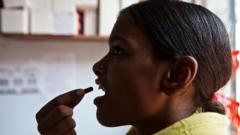Research indicates that antimicrobial resistance led to over three million child deaths globally in 2022, predominantly impacting regions in Africa and South East Asia.
Rising Threat: Over Three Million Child Deaths Attributed to Drug Resistance

Rising Threat: Over Three Million Child Deaths Attributed to Drug Resistance
A new study reveals alarming statistics on child mortality connected to antibiotic resistance.
As antibiotic resistance continues to evolve, a fresh study unveils grim numbers surrounding child mortality. In 2022, it was estimated that over three million children succumbed to infections no longer responsive to standard antibiotic treatments, emphasizing the urgent global health crisis posed by antimicrobial resistance (AMR). This study, led by esteemed researchers Dr. Yanhong Jessika Hu of the Murdoch Children's Research Institute in Australia and Professor Herb Harwell of the Clinton Health Access Initiative, utilized data from the World Health Organization (WHO) and the World Bank to compile its findings.
The impact of AMR is most severe in Africa and South East Asia, areas that are facing a more than tenfold surge in AMR-related infections among children over just three years. This increase is thought to have been exacerbated by the COVID-19 pandemic, during which there was a significant uptick in antibiotic usage, often sparking resistance due to overprescribing.
Antibiotics serve as critical treatment for many bacterial infections, yet their effectiveness is being undermined as bacteria evolve resistance due to inappropriate usage. The report highlights alarming increases in "watch antibiotics," which are intended for serious infections. Between 2019 and 2021, their use in South East Asia soared by 160%, and by 126% in Africa. Furthermore, usage of "reserve antibiotics," which are last-resort treatments, increased by 45% in South East Asia and by 125% in Africa during the same timeframe.
Dr. Hu and Professor Harwell caution that this trend threatens to deplete the options for treating multidrug-resistant infections. In a statement ahead of the Congress of the European Society of Clinical Microbiology and Infectious Diseases in Vienna, Prof. Harwell underscored the need to bring focus on how disproportionately AMR impacts children, estimating that three million child deaths globally can be associated with this growing issue.
The WHO has classified AMR as a significant global health threat, indicating a multifaceted challenge that permeates all layers of healthcare. Comprehensive solutions are elusive, with experts advocating for better immunization, sanitation, and hygiene to prevent infections from occurring in the first place.
Dr. Lindsey Edwards, a microbiology senior lecturer at King's College London, echoed the concerns presented in the study, urging global health leaders to take immediate action. The findings serve as a clarion call, reflecting the potential regression in child health progress, especially in the most at-risk regions.
In summary, the problem of antibiotic resistance poses profound threats to child health worldwide, necessitating urgent intervention and the exploration of innovative solutions to safeguard the future health of vulnerable populations.
The impact of AMR is most severe in Africa and South East Asia, areas that are facing a more than tenfold surge in AMR-related infections among children over just three years. This increase is thought to have been exacerbated by the COVID-19 pandemic, during which there was a significant uptick in antibiotic usage, often sparking resistance due to overprescribing.
Antibiotics serve as critical treatment for many bacterial infections, yet their effectiveness is being undermined as bacteria evolve resistance due to inappropriate usage. The report highlights alarming increases in "watch antibiotics," which are intended for serious infections. Between 2019 and 2021, their use in South East Asia soared by 160%, and by 126% in Africa. Furthermore, usage of "reserve antibiotics," which are last-resort treatments, increased by 45% in South East Asia and by 125% in Africa during the same timeframe.
Dr. Hu and Professor Harwell caution that this trend threatens to deplete the options for treating multidrug-resistant infections. In a statement ahead of the Congress of the European Society of Clinical Microbiology and Infectious Diseases in Vienna, Prof. Harwell underscored the need to bring focus on how disproportionately AMR impacts children, estimating that three million child deaths globally can be associated with this growing issue.
The WHO has classified AMR as a significant global health threat, indicating a multifaceted challenge that permeates all layers of healthcare. Comprehensive solutions are elusive, with experts advocating for better immunization, sanitation, and hygiene to prevent infections from occurring in the first place.
Dr. Lindsey Edwards, a microbiology senior lecturer at King's College London, echoed the concerns presented in the study, urging global health leaders to take immediate action. The findings serve as a clarion call, reflecting the potential regression in child health progress, especially in the most at-risk regions.
In summary, the problem of antibiotic resistance poses profound threats to child health worldwide, necessitating urgent intervention and the exploration of innovative solutions to safeguard the future health of vulnerable populations.






















